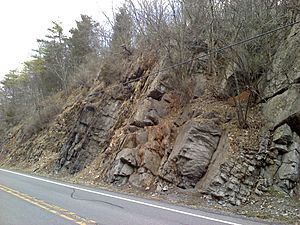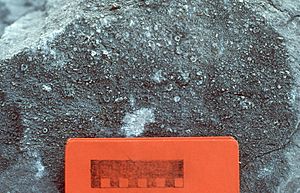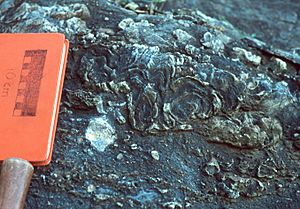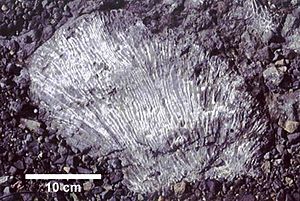Keyser Formation facts for kids
Quick facts for kids Keyser FormationStratigraphic range: Pridoli-Lochkovian |
|
|---|---|

Outcrop of the Keyser Formation on U.S. Route 522 in Fulton County, Pennsylvania, north of Warfordsburg
|
|
| Type | Sedimentary |
| Unit of | Helderberg Group |
| Sub-units | Byers Island, Jersey Shore & La Vale Members |
| Underlies | New Creek Limestone and Old Port Formation |
| Overlies | Tonoloway Formation |
| Thickness | 33 m (108 ft) at Allegheny Furnace |
| Lithology | |
| Primary | Limestone |
| Location | |
| Coordinates | 38°18′N 79°36′W / 38.3°N 79.6°W |
| Approximate paleocoordinates | 36°18′S 41°30′W / 36.3°S 41.5°W |
| Region | Pennsylvania, Maryland, Virginia, West Virginia |
| Country | |
| Extent | Appalachian Mountains |
| Type section | |
| Named for | Keyser, West Virginia |
| Named by | E. O. Ulrich |
| Year defined | 1911 |
Imagine a time long, long ago, when ancient seas covered parts of North America! The Keyser Formation is a special type of rock that formed during the late Silurian and early Devonian periods. It's mostly made of limestone and can be found in Pennsylvania, Maryland, Virginia, and West Virginia. Geologists study these rocks to learn about Earth's past.
Contents
What is the Keyser Formation?
The Keyser Formation is a type of rock found in the ground. At its main discovery spot in Keyser, West Virginia, it looks like bumpy, lumpy limestone (called 'nodular'). Above this, you can see layers of limestone that are both thick and thin, and some even look like they have tiny stripes or layers.
In central Pennsylvania, the bottom part of the rock is a gray limestone that often has small, clear patches. This part is full of fossils! Above it, there's more lumpy limestone that also has many fossils. Higher up, you can find rock made of tiny pieces of crinoids (ancient sea animals). The very top layers switch between striped limestone and limestone that's a bit muddy and full of fossils.
Where Did the Keyser Formation Form?
Scientists believe the Keyser Formation formed in shallow parts of an ancient ocean. It also formed in areas like tidal flats, which are muddy or sandy areas near the coast that are covered and uncovered by ocean tides. These environments changed over time, creating different layers of rock.
How Does the Keyser Formation Connect to Other Rocks?
The Keyser Formation sits on top of another rock layer called the Tonoloway Formation. They likely formed one after the other without a big break. Above the Keyser Formation, you'll find the Old Port Formation, and these two layers also connect smoothly.
Geologists have divided the Keyser Formation into three main parts, or "members." From the bottom up, they are:
- Byers Island Member: Named after Selinsgrove, Pennsylvania.
- Jersey Shore Member: Named after Jersey Shore, Pennsylvania.
- La Vale Member: Named after La Vale, Maryland.
In Virginia and West Virginia, the Keyser Formation is split into an Upper and Lower part by a layer of shale called the Big Mountain Shale Member.
What Fossils Are Found in the Keyser Formation?



The Keyser Formation is famous for its many fossils! These fossils help scientists understand what life was like millions of years ago. Some common fossils found here include:
- Crinoid columnals: These are like the "stem" pieces of ancient sea lilies.
- Stromatoporoids: These were sponge-like creatures that built large, layered structures on the seafloor.
- Brachiopods: These are marine animals with two shells, similar to clams but from a different group.
- Tabulate corals: These were ancient corals that grew in colonies and formed honeycomb-like structures.
- Conodonts: These are tiny, tooth-like fossils from eel-like creatures that lived in the ancient oceans.
Where Can You See the Keyser Formation?
You can see the Keyser Formation in many places, especially where roads or quarries have cut into the ground. Some notable spots include:
- Keyser, West Virginia: This is where the rock formation was first officially described.
- Old Eldorado Quarry: Located along I-99 in Blair County, Pennsylvania.
- Alleghany Furnace Quarry: Near Altoona, Pennsylvania.
- St. Clairsville/Osterburg Exit: Along I-99 in Bedford County, Pennsylvania.
- Abandoned quarry in Tyrone, Pennsylvania.
- Quarry at Canoe Creek, Pennsylvania.
- New Enterprise New Paris Quarry: On Chestnut Ridge in Bedford County, Pennsylvania.
- Roadcut along U.S. Route 30 (Everett bypass) through Warrior Ridge, Bedford County, Pennsylvania.
- Strait Creek section: In Highland County, Virginia.
- Smoke Hole section: In Pendleton County, West Virginia.
How Old is the Keyser Formation?
Scientists use different methods to figure out the age of rock layers. For the Keyser Formation, they've determined it formed during the late Silurian period and continued into the early Devonian period. This means it's incredibly old, dating back hundreds of millions of years! Tiny conodont fossils found in the rock helped scientists confirm this age.

